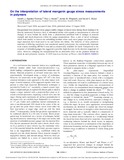- CERES Home
- →
- Cranfield Defence and Security
- →
- Staff publications (CDS)
- →
- View Item
JavaScript is disabled for your browser. Some features of this site may not work without it.
| dc.contributor.author | Appleby-Thomas, Gareth J. | - |
| dc.contributor.author | Hazell, P. J. | - |
| dc.contributor.author | Wilgeroth, J. M. | - |
| dc.contributor.author | Wood, D. C. | - |
| dc.date.accessioned | 2011-06-14T23:29:05Z | |
| dc.date.available | 2011-06-14T23:29:05Z | |
| dc.date.issued | 2010-12-31T00:00:00Z | - |
| dc.identifier.issn | 0021-8979 | - |
| dc.identifier.uri | http://dx.doi.org/10.1063/1.3460812 | - |
| dc.identifier.uri | http://dspace.lib.cranfield.ac.uk/handle/1826/5507 | |
| dc.description.abstract | Encapsulated wire-element stress gauges enable changes in lateral stress during shock loading to be directly monitored. However, there is substantial debate with regards to interpretation of observed changes in stress behind the shock front; a phenomenon attributed both to changes in material strength and shock- dispersion within the gauge-encapsulation. Here, a pair of novel techniques which both modify or remove the embedding medium where such stress gauges are placed within target materials have been used to try and inform this debate. The behavior of three polymeric materials of differing complexity was considered, namely polystyrene, the commercially important resin transfer moulding RTM 6 resin and a commercially available fat lard. Comparison to the response of embedded gauges has suggested a possible slight decrease in the absolute magnitude of stress. However, changing the encapsulation has no detectable effect on the gradient behind the shock in such polymeric systems. | en_UK |
| dc.language.iso | en_UK | en_UK |
| dc.publisher | American Institute of Physics | en_UK |
| dc.subject | impact | en_UK |
| dc.subject | shock | en_UK |
| dc.subject | lateral gauge | en_UK |
| dc.subject | hugoniot | en_UK |
| dc.subject | strength | en_UK |
| dc.subject | polymers | en_UK |
| dc.title | On the interpretation of lateral manganin gauge stress measurements in polymers | en_UK |
| dc.type | Article | en_UK |
Files in this item
This item appears in the following Collection(s)
-
Staff publications (CDS) [1209]
